Asphalt Industry OEMs Target What Each Operator Needs
BY Sandy Lender
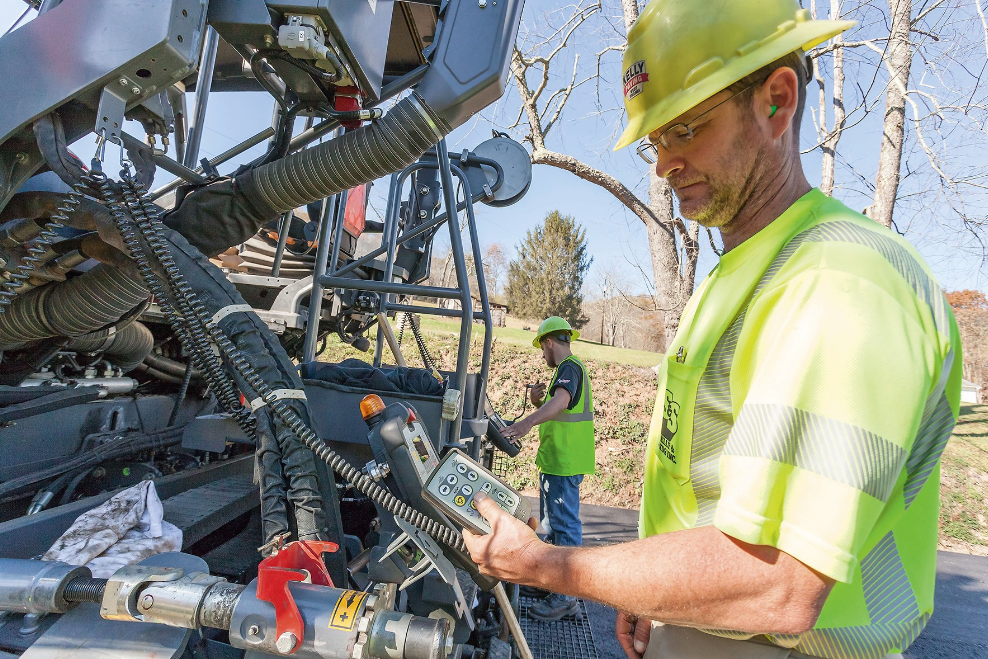
While they tackled placing large Tier 4 engines, after-treatment systems and diesel exhaust fluid tanks in machines for the January 2017 deadline, asphalt industry OEMs (original equipment manufacturers) saw problems with visibility creeping into design. They worked to solve those challenges to create an environment that is both safe and smart from the operator’s point of view. For just one of many examples we could list, CASE Construction Equipment, Racine, Wisconsin, put the Deutz engine in the center, under the operator, for its new DV209D HF asphalt roller.
Then, the attention OEMs and industry have given to silica dust levels around milling machines since 2003 has actually revolved around the safety and comfort of the operator of the equipment. For just one of many examples we could list, the BM 2200/75 from BOMAG Americas, Ridgeway, South Carolina, pulls silica dust away from the operator with its 120-kg dust reduction system.
Beyond noise and dust mitigation, beyond line-of-sight considerations, even beyond ergonomics, OEMs have added new models of equipment within larger series to address specific work capacities for the operator. For the past few years, engineering and development has zeroed in on the fellow who runs the machine. For examples of how OEMs are targeting what each operator needs, let’s take a look at some of the new iron and new technology that was on display during the March 7 through 11 CONEXPO-CON/AGG 2017. And there was plenty of it with more than 2.8 million net square feet of exhibits from more than 2,800 exhibitors around the globe.
We looked at the availability of milling options from Caterpillar of Peoria, Illinois, specifically on page 48. Additional OEMs around the globe know that a contractor needs a half-lane—or larger—cutting drum for highway class milling and a smaller drum and lower operating weight for tighter, commercial or residential projects. Such OEMS offer a range of machines and drums in the cold planing arena for contractors. Let’s take a look at other areas where OEMs address the specific needs of contractors with iron options, and we’ll use CAT’s mid-sized wheel loaders, those in the 5 ½ to 6-ton range, as an example.
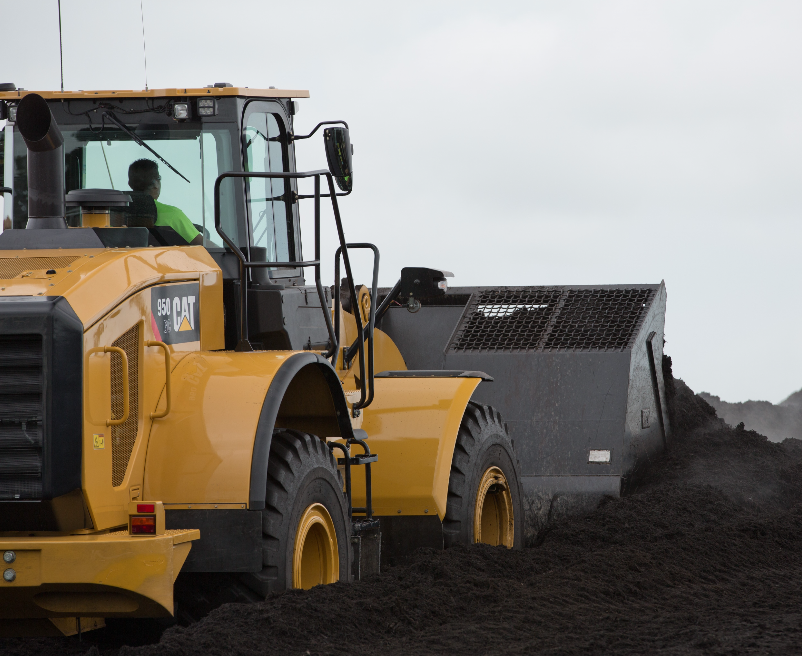
The 950 GC mid-sized wheel loader from Caterpillar, Peoria, Illinois, offers a simpler operator station and optimized bucket for applications that are a bit lighter weight than what the 950M was designed to take on. This makes the 950 GC ideal for the contractor who doesn’t need as much lift, according to the manufacturer.
The 950M has been out for a while, but Caterpillar is launching the 950 GC with similar capacity. The reason behind this is to offer customers a machine with high performance but easier functions. CAT’s Kristin Girard explained that customers were asking for a mid-sized wheel loader that was simple and easy to use. The GC is how CAT has answered. The idea behind the 950 GC is to offer a machine with fewer bells and whistles. For contractors who may not need to move heavy material all the time, the Performance Series bucket cuts down on fuel use and the new operator platform gives the operator fewer “things” to worry about. I don’t think anyone in the room during the pre-CONEXPO press event called it the Goldilocks of loaders, but that’s what went through my mind while listening to product specialists describe the differences between the 950 GC and the 950M loaders. It’s not too big; it’s not too small; it’s just right for those applications where the 950M might be too much for the operator to handle.
Don’t let that line of thinking lead you to believe anyone is denigrating the operator. From Ammann to Wirtgen and every manufacturer of the alphabet in between, product specialists on the tradeshow floor were talking about making life easier for new-to-the-industry operators and new-to-a-particular-machine operators. They also discussed making equipment match up to each task at hand.
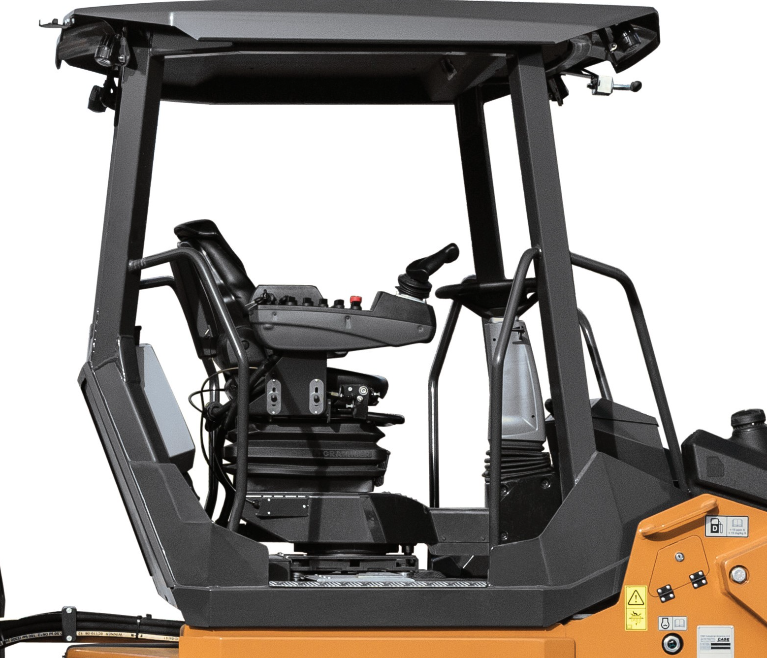
The DV210D—pictured here—and DV209D from CASE Construction Equipment, Racine, Wisconsin, feature a fully adjustable and intuitive operator environment with a steering wheel instrument cluster and digital display. The operator platform features a spacious environment with an adjustable sliding/rotating seat to provide visibility of the drum surfaces, edges and spray bars. The operator station also features a tilting and adjustable-height steering column and adjustable armrests with integrated control switches. A multifunctional display mounted on the steering wheel provides the operator real-time operation data, precision controls and diagnostics.
Practical and Intuitive
The vice president for CASE North America, Scott Harris, spoke to the media during the company’s press briefing about the practical and intuitive features built into new equipment. Five of seven new G Series wheel loaders were on display at the show with what Harris called “a completely evolved cab experience” and “intuitive environment.” Even when talking about CASE’s new excavators, he mentioned the “new, enlarged, spacious operators’ cabs.” Of the three new asphalt rollers from CASE, the DV209D HF includes a color, intelligent compaction display screen in the steering wheel so the operator doesn’t have to continually shift his focus within the cab.
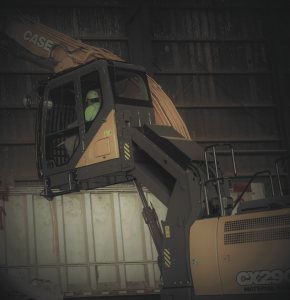
While the CX290D material handler from CASE isn’t a common piece of equipment for the asphalt professional, the design around the operator station speaks directly to the company’s focus on worker safety and comfort. The optimized hydraulic circuits on the arm and boom are designed to reduce shock in the cab. The CX290D also features additional guarding on the cab and undercarriage to protect the operator—and machine—during tough waste and scrap handling applications. The machines, built as part of the CASE D Series excavators, also feature best-in-class cab space, excellent visibility and a pressurized and iso-mounted cab that keeps noise and vibration down, according to the manufacturer. A standard Bluetooth radio gives operators hands-free functionality. A standard rearview camera feeds a 7-inch widescreen monitor that also provides operators with real-time access to performance parameters such as fuel consumption and operating hours. These are examples of the technology OEMs are using in a wide range of machines to enhance operator and equipment performance.
The team at Sakai America, Adairsville, Georgia, also made a change to the operator experience, launching a cabbed version of its SW994 vibratory double-drum roller at CONEXPO-CON/AGG. The rig is designed to protect operators in extreme climates and offer a quieter, dust-free environment. The seat offers five positions to choose from ranging from front-facing to plus or minus 45 degrees, and plus or minus 90 degrees, depending on working lane. To swivel the seat, operators simply depress the pedal at the lower right side to release the lock while sitting.
Sakai’s Josh Steele had a logical response to the reasoning behind the attention OEMs have given operator comfort. “If they enjoy their job more, they’ll be more productive.”
Bert Erdmann at BOMAG echoed that sentiment, saying the operator’s comfort level was important for reducing fatigue and improving performance. He pointed out that OEMs have tackled machine operating efficiencies; it was time for OEMs to ensure the people running the machines could do so at their best efficiency, as well. He used the improved cab of the 28 RH pneumatic roller from BOMAG as an example, showing how easily the operator can slide the platform from side to side and swivel the seat to get an excellent view of the drum edge.
Look at the Generation VI asphalt rollers from Atlas Copco that feature temperature sensors in the front and rear. They’re giving data coming and going, but they’re doing so automatically. As Dynapac’s Tim Hoffman said, the CA1400D is a bit simpler than the 1500, making it a wise choice for the rental market especially. An operator can climb into the cab and get to work faster. The CC4200 VI and CC6400 feature the enclosed cab for operator comfort as well.
Even crushing equipment on display at CONEXPO-CON/AGG had simplicity designed in. The new Rapideploy from Eagle Crusher, Galion, Ohio, takes one worker about 30 minutes to deploy, according to Daniel Friedman. “It’s a simpler machine,” he said. “They can use the variable frequency drive or not; they can use the telematics or not; they can just push a button and crush.” What happens is the operator unloads the crusher at the site, pulls the lever, and the sequenced conveyor systems extend themselves. Scrapers on the belts handle cleaning and “tall” conveyor heights—up to 15 feet, 3 inches for the fines discharge—help you build piles in a manner that doesn’t create a mess.
Kleemann, a Wirtgen Group Company, introduced its Spective control system, which is designed to keep the crushing operation simple, without the need for lengthy instruction. They call it an intuitive crushing plant control concept, saying it’s easy to understand and support the operator in his work. As controls systems around the tradeshow floor boasted, Spective also is designed to guide users through startup. An intriguing feature is Spective’s fault localization, which attendees also saw on the Gencor Ultralogiks® total plant control system. If a fault occurs during crusher machine operation with Spective, or during plant operation with Ultralogiks, downtime is reduced with fault localization. In other words, these systems show the operator where the fault diagnosis is. The operator can look at a display screen on the operator panel or in the control house, and see where he needs to send the technician to get up and running again.
That kind of diagnostic help, from fault codes and localization to predictive diagnostics, was on display all around the tradeshow floor to give operators a break.
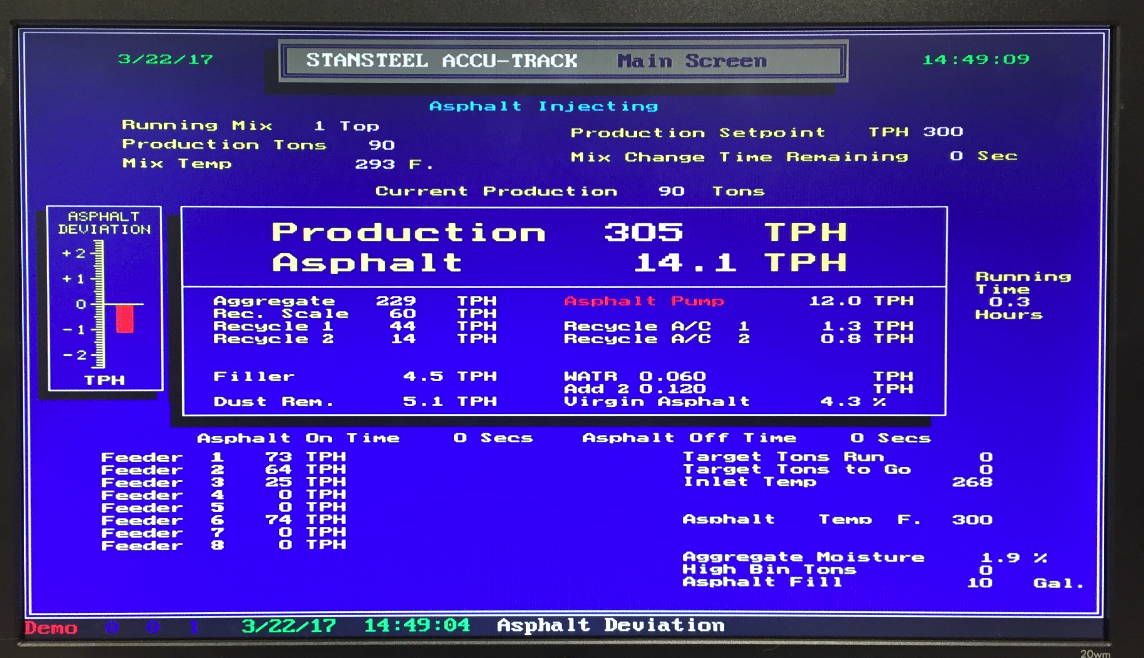
The Accu-Track® Total Plant Control from Stansteel, Louisville, Kentucky, is designed to monitor all points on the plant and alert the operator if there’s a fault.
Predictive Maintenance
OEMs aren’t trying to disparage operators, but offering solutions to a real problem contractors face: not all new operators show up on the job site with full knowledge of each machine. Even veteran operators face a learning curve when a new piece of equipment is delivered to the shop or when they move from one paving crew to another.
“We want to keep our operation simple,” Kleemann’s Mark Hezinger said. “Sometimes the operator is overwhelmed. Sometimes the new operator is not the most productive.”
Caterpillar’s A.J. Lee shared that cold planer customers asked for a machine that took under an hour to learn. Vogele’s Laikram Narsingh shared that standardizing drive systems across machine types has given crews more flexibility.
“Hamm’s new Easy Drive system is a standardized logic that is adapted to each model’s series,” Narsingh said. “Easy Drive is characterized by an intuitive yet safe user interface that has a logic standard across all types of rollers, offering minimal learning curves. That being said, while it’s important to cross-train paver crews, it’s best if a crew stays with a paver. Keeping the same crew with the equipment, as much as practically possible, allows them to take ownership and pride in their machine. While our advanced controls allow for crew changes with little to no operational training needed, you can minimize the learning curve with a dedicated crew.”
John Irvine, the president of Roadtec, an Astec Company of Chattanooga, Tennessee, shared how the company’s Guardian system can also shorten the learning curve while offering a cost savings to the contractor. Consider the true cost of a simple machine failure on a job. Even something “quick” to fix in two to three hours has your company paying 10 to 12 workers to watch 40, 60, 80 or more tons of perishable mix cool right out of spec. During a walk-around of the Roadtec equipment, Irvine pointed to a sensor that is part of the Guardian system from Roadtec, and explained that it can send reports to the mechanic alerting the mechanic if something is about to go wrong. Instead of a machine stopping because a filter wasn’t changed in a timely fashion, mechanics know when to get filters or hoses changed, when to prevent bigger problems from shutting down a job.
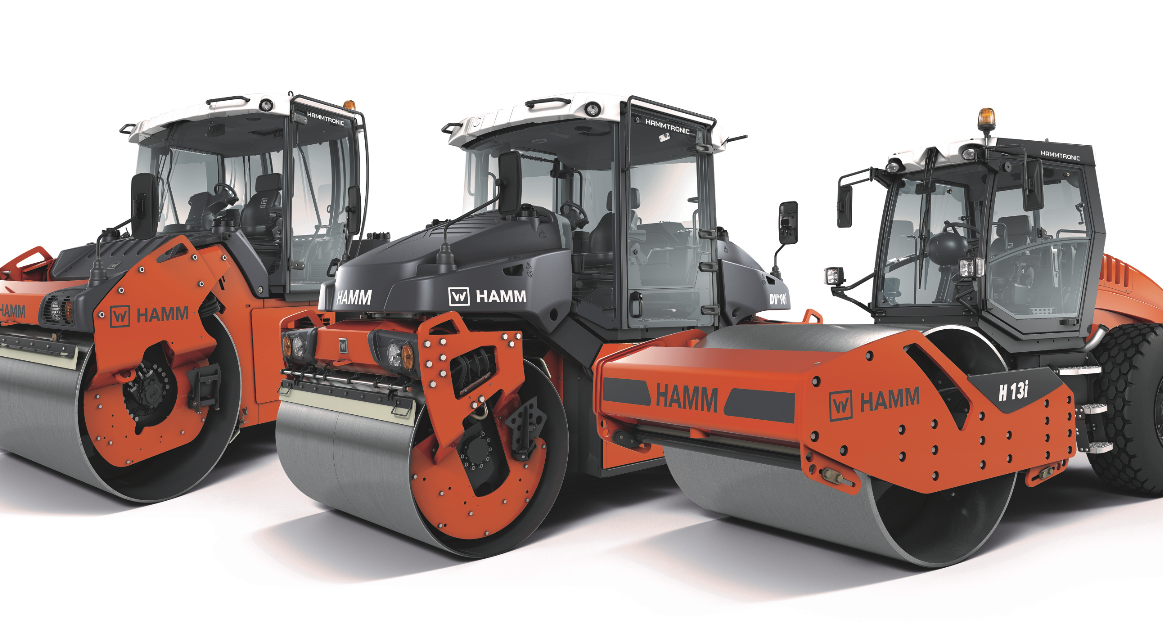
Hamm, a division of the Wirtgen Group, Nashville, Tennessee, has integrated the Easy Drive operating concept in the tandem rollers of the DV+ and HD+ series, and in the H series compactors. All rollers now have the same colors for the same function groups and a common design, adapted to the specific functions of the series. “If all Hamm asphalt construction and earthwork rollers operate with Easy Drive, anyone who has ever operated a ‘Hamm’ will instantly feel at home on all other Hamm rollers,” Dr. Axel Romer, head of development and design at Hamm, explained. “In this way, we make life easier for operators when switching to a different machine type. They instantly identify important functions. This enables top-quality work right from the start and quickly builds up confidence.” As seen in the illustration of the Easy Drive cab, the centerpiece is its clear operating structure with a steering wheel for steering and all other essential functions operated via the joystick with clearly visible buttons, and the multi-function armrest.
Predictive maintenance tools such as Guardian do more than monitor filter changes these days. Irvine referred to Guardian as an asset management system. “Guardian looks after the machine, the crew and the job bid,” Irvine said. “Guardian wants to be your partner in business.”
John Deere, Moline, Illinois, formally launched its machine monitoring center “concept” during CONEXPO-CON/AGG 2017. With the newly minted machine health monitoring center, John Deere personnel and dealers analyze data and proactively support customers through technology.
“Data from thousands of connected John Deere machines flows here,” Tim Worthington said. He’s the manager, product support services, for John Deere Construction & Forestry. “The machine health monitoring center is the central nervous system of our monitoring network.”
Trained dealer specialists use advanced telematics and alert-management tools to stay on top of potential issues. When necessary, they can engage trained technicians who then read and clear diagnostic codes, record machine performance data and update software, without ever visiting the machine in the field.
Roadtec’s Irvine explained how that principle has been working with the Guardian system. The telematics recognize when there’s a fault in the machine and give notice to the operator, the mechanic in the shop, the Roadtec personnel in Chattanooga, or any designated combination thereof. In the event that the equipment operator has made a mistake when programming the settings on a machine, technicians at Roadtec can “go into” the computer and reset it. If a problem comes up, technicians can make corrections without having to send a worker into the field. Thus using telematics not only saves time and man hours, it offers a level of predictive expertise.
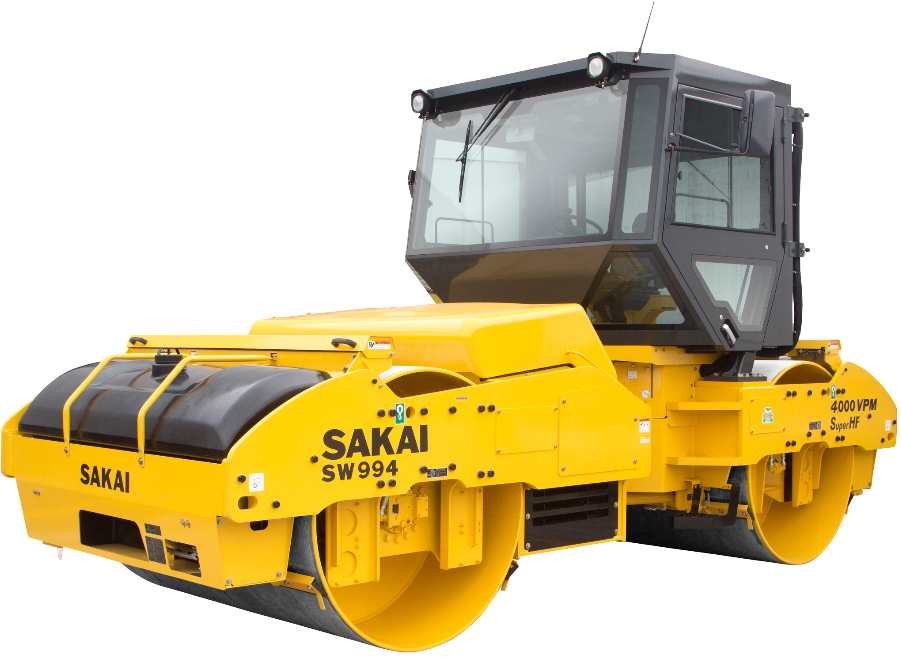
The SW994 from Sakai America, Adairsville, Georgia, is the first double-drum the company has put a cab on, according to Josh Steele. With cab, the machine has a maximum operating weight of 31,401 pounds. The high-frequency vibe roller offers low-profile vibration at 4,000 vpm. Operators simply flip a switch to choose frequency and amplitude or no vibe from front or rear drum, independent of each other.
Technology vs Operator
What the product offers your bottom line determines its value in the end. Caterpillar’s Downing shared the truth that the paving industry is highly competitive. “The role of technology is to provide efficiency, precision and consistency in the work,” he said. “This allows the contractor to confidently bid for work and ensures quality, on-time production. Success leads to more work and growth of the business.”
When operators of equipment are physically comfortable and able to move freely within the environment of the cab, and when they understand and know how to use all the functions of the machine, they are going to make fewer mistakes. They will be safer, more consistent workers. “And that’s what it boils down to for asphalt paving contractors,” Vogele’s Narsingh said, “what’s coming out the back end of the machine.”
As Michael Haberman, director of CONEXPO-CON/AGG and CEO of Gradall, stated, “The workforce shortage has become an issue again. These things are cyclical. We’ve gone from a time when you could practically fix a machine with a hammer and a wrench to now when you better not touch a machine with a hammer and a wrench.” Instead, we have OEMs design equipment that is easier for the new-to-the-workforce operator to master and we have engineers prepare the onboard diagnostics that help mechanics predict failures before they happen.

Michael Halada
Michael Halada
Global Product Manager for Automation, Ammann
“The as1 Control System is a fully featured, fully automatic plant control system with a very intuitive user interface to help even inexperienced operators succeed. Operators simply select the desired recipe and quantity. Then they click the ‘play’ button. This automatically starts the required drives, selects the right tanks for production, and produces according to the recipe’s set values. The user will be informed visually if any irregularities occur. Even in manual mode, the as1 Control System helps prevent major issues.”

Tim Hoffman
Tim Hoffman
Product Manager for Rollers, Atlas Copco
“Operator skill level certainly plays a part in the quality of a project, but we believe high-quality results should be easily attainable for all levels of experience. We’ve developed some technologies to do this, including our center drive auger system on our pavers, which features a 6-inch–wide chain box and 17-inch diameter flights to ensure continuous, uniform material flow and minimize centerline segregation. The way the feed control system efficiently lays material contributes to the overall quality and finish of the asphalt. Also, our auger-conveyor feed-control systems feature four ultrasonic sensors to measure the paving material and automatically adjust the conveyor and auger to optimize material flow. This minimizes segregation and delivers a constant head of material as well as the smooth flow needed to produce high-quality mats.”

Brad Stemper
Brad Stemper
Product Manager, CASE Construction Equipment
“The ideas of simplified operation and improved quality work hand-in-hand. We have focused specifically on the scalability and growth possibilities of some of these technologies. Precision technologies include non-traditional machine control solutions, such as simple and easy to use features that enhance an operator’s performance. This includes bucket and blade controls that take routine operations and automate them to improve speed, consistency, and most importantly safety on the job site. Contractors don’t need to dive straight into advanced 3D or 4D systems (although our equipment works really well with them), but they can start with a fairly basic 2D system that brings them immediate benefits at a lower price point, and then scale those systems up later when they’re ready. You’ve got to learn to walk before you run, and we focus on that with both our dealers and our customers. Making the operator and equipment owner comfortable with technology—and not intimidated—will make it more likely for them to be open to exploring new technology in the future.”
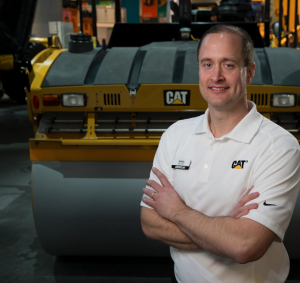
Bryan Downing
Bryan Downing
Global Sales Support Consultant, Caterpillar Paving Products
“‘Smart’ machines are changing the way work is done. This change comes as a result of the need to meet new, more exacting standards and/or to provide an efficiency advantage. The challenge for manufacturers is to provide technology solutions that deliver value to the customer without exceeding what they can reasonably deploy or afford to invest in. Smart machines allow operators with lesser experience to be as efficient as more experienced operators.
“Caterpillar uses intuitive push button control systems that allow any operator to be fully effective at first introduction to the machine. In addition to uniform machine controls, Cat’s mapping and grade control systems use common displays, uniform operator inputs to enable operators to move between machines. Finally, the Cat CB10 and CD10 asphalt compactors can be equipped with the Automatic Adjustable Compaction (AAC) system….Simply set the system in automatic, activate the vibratory system, and focus on performing a consistent rolling pattern. When the machine is in automatic, the onboard accelerometer and processors calculate and automatically adjust the amplitude to create the quickest and highest quality compaction by applying the most compaction energy the layer can accept on initial passes followed by automatic amplitude adjustments to reduce the energy to eliminate overcompaction…”

John Irvine
John Irvine
President, Roadtec Inc.
“The Guardian system from Roadtec is meant to serve on all fronts. The operator now knows when the machine needs filter/oil changes or the radiator cleaned because Guardian tells him via email or machine alerts. It also signals the shop manager or anyone designated. The project manager can look at his job during the day and see tons laid, squares cut, efficiency of machine, paving speed in feet per minute, or teeth used on a milling job, fuel burned, etc. He knows if the crew is being productive to the standards bid. If not, he can call the operator or foreman to understand the ‘real time’ impediments to success.
“If you want to know if a machine has been moved or the current position of the machine, it logs the last place the machine was located before the ignition is turned off. If you want to know how many minutes your mill has been cutting versus how long the machine has been idling, Guardian will tell you. If you want an email at the end of the day telling how many tons have been laid by one, two or numerous pavers, Guardian will monitor and report.”
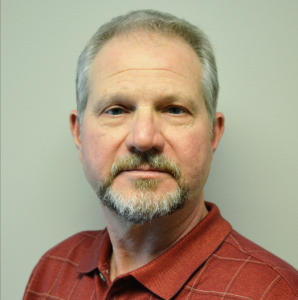
Greg Gilpin
Gregg Gilpin
Director of Electronic Control Systems, Stansteel
“The goal of any asphalt plant electronic control is to make an absolute quality product that can meet any testing or end result requirement specified by the asphalt producer or governing agency. Stansteel has developed a system called the Accu-Track® Total Plant Control—with Quality Assurance™ (patent pending). The basic principle behind this system is its ability to continuously monitor any and all points on the plant that contribute to the metering, weighing, and blending of ingredients. Not only are individual aggregates, RAP/RAS, and liquid asphalt analyzed, but also smaller proportioned materials such as metered dust, hydrated lime, and liquid additives like water and Evotherm for foaming.
“The Accu-Track features a Closed Loop™ process that requires a feedback signal from each material conveying component. This provides the system instant verification the equipment is operating as designed and that each key ingredient is fed within the specified range. At any time, audible and visual alarm messages may alert the operator that a material flow is out of range, potentially initiating an automatic plant shutdown.”

Laikram “Nars”Narsingh
Laikram “Nars” Narsingh
Commercial Support and Development Manager, Vogele
“For our new line of Super pavers for North America—the 10-foot tracked Super 2000-3i and wheeled Super 2003-3i—our exclusive ErgoPlus 3 operating system offers ergonomic and functional advantages that will enhance productivity for both new and experienced crews. ErgoPlus 3 focuses on the operator, who retains full control over the paver despite his task being made easier by an improved operator’s platform, operator’s console, screed console, and the Niveltronic Plus system for automatic grade and slope control. On the operator’s console, all controls are clearly arranged. Paver functions are clustered in logical groups so operators can find them quickly under the demands of the job. All push buttons are identifiable by touch, even when wearing work gloves. And Vogele’s “Touch and Work” philosophy means once a button is pressed, the function is executed directly without a need to confirm.
“Morning start-ups are made easier via Vogele self diagnostics and sensors for all engine vitals, which eliminate daily checks. The engine is daily maintenance-free.
“Likewise, for asphalt and soil compactors, Hamm’s new Easy Drive system is a standardized logic that is adapted to each model’s series. Contractors now will be able to be flexible by assigning machine operators to all types of rollers and compactors. Easy Drive is characterized by an intuitive yet safe user interface that has a logic standard across all types of rollers, offering minimal learning curves.”
Mark Eckert
Global Product Manager, Volvo Construction Equipment
“Seemingly small mistakes by the operator can have an enormous impact on mat quality, thus may of the new features on pavers and compactors developed over the past decade are designed to reduce the occurrence of operator error. Speed limiters, grade and slope control, auto vibration and material-flow sensors on the screed are all perfect examples of technologies that help automate some of the tasks that could cause job quality problems at the hand of an inexperienced operator.
“Perhaps the biggest innovation in this regard is intelligent compaction (IC). Features such as pass mapping and temperature mapping can provide an inexperienced operator with real-time information that is easy to understand, and with minimal training the operator can make informed decisions on the fly to ensure uniform passes and compaction at peak temperatures….Compact Assist, the Volvo Intelligent Compaction System with Density Direct™, uses a simple calibration process to ‘train’ the system for the specific material being compacted. Since it is calibrated every time a change is made to lift thickness or mix design, the measurement value displayed is going to be consistent. The Compact Assist screen provides numbers that an operator of any skill level should be incredibly familiar with, because they’re directly tied to the job specification. In other words, the operator may be working to meet a target density of 96 percent on the project. In real time, the operator can see how close they are to achieving that target density across the entire mat. It doesn’t get any simpler than that.”
